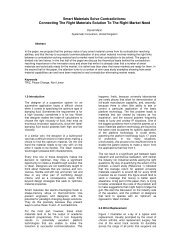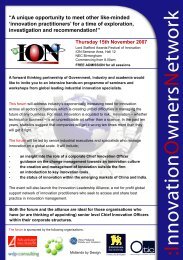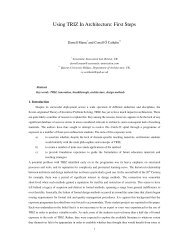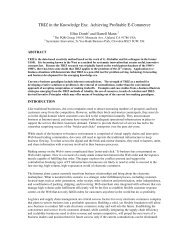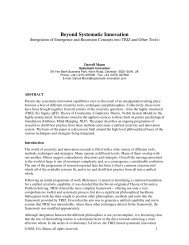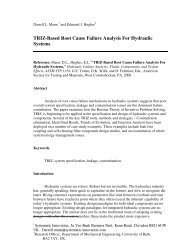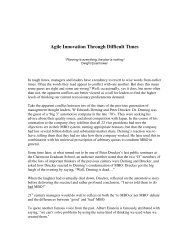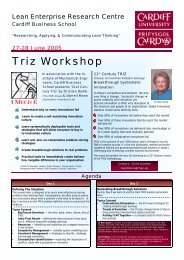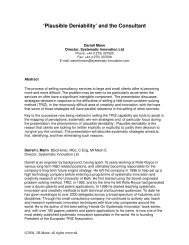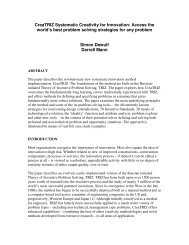systematic win-win problem solving in a business environment
systematic win-win problem solving in a business environment
systematic win-win problem solving in a business environment
Create successful ePaper yourself
Turn your PDF publications into a flip-book with our unique Google optimized e-Paper software.
SYSTEMATIC WIN-WIN PROBLEM SOLVING<br />
IN A BUSINESS ENVIRONMENT<br />
Darrell Mann<br />
Systematic Innovation<br />
5a Yeo-Bank Bus<strong>in</strong>ess Park<br />
Kenn Road, Clevedon BS21 6UW UK<br />
Phone: +44 (1275) 337500<br />
Fax: +44 (1275) 337509<br />
E-mail: Darrell.Mann@<strong>systematic</strong>-<strong>in</strong>novation.com<br />
ABSTRACT<br />
TRIZ research has shown that the strongest solutions and ideas are the ones <strong>in</strong> which the<br />
<strong>problem</strong> or opportunity owner has successfully challenged the conflicts and trade-offs<br />
that others have assumed to be fundamental. Classical TRIZ <strong>in</strong>cludes a Matrix that<br />
enables owners of technical <strong>problem</strong>s to quickly identify the <strong>in</strong>ventive strategies used by<br />
others fac<strong>in</strong>g similar design conflicts. The paper describes the creation of a brand new<br />
Contradiction Matrix tool aimed specifically at bus<strong>in</strong>ess applications of TRIZ. The tool is<br />
believed to offer <strong>problem</strong> solvers the same ready access to the best of other bus<strong>in</strong>ess<br />
solutions, and as such offers a previously unknown <strong>problem</strong> <strong>solv<strong>in</strong>g</strong> capability. The new<br />
tool has been constructed from the analysis of a large proportion of the published<br />
knowledge on bus<strong>in</strong>esses that have successfully challenged the <strong>w<strong>in</strong></strong>-lose contradictions<br />
their competitors had not recognised or assumed were not challengeable. In all, several<br />
hundred <strong>w<strong>in</strong></strong>-<strong>w<strong>in</strong></strong> cases have been identified and <strong>in</strong>cluded <strong>in</strong> the analysis. The paper<br />
describes some of the most well known of these cases - and how they have <strong>in</strong>fluenced the<br />
structur<strong>in</strong>g and content of the new Matrix. A short f<strong>in</strong>al section of the paper describes<br />
how the new Matrix is beg<strong>in</strong>n<strong>in</strong>g to be used to successfully generate <strong>w<strong>in</strong></strong>-<strong>w<strong>in</strong></strong> solutions to<br />
real bus<strong>in</strong>ess <strong>problem</strong>s that would normally be solved us<strong>in</strong>g conventional either/or<br />
th<strong>in</strong>k<strong>in</strong>g strategies.<br />
INTRODUCTION<br />
Question. What have Cisco, Virg<strong>in</strong>, Schwab, GE Capital, Benetton, Enron, South West<br />
Airl<strong>in</strong>es, Home Depot, Wal-Mart, America West, eBay, Barnes and Noble, Body Shop,<br />
Sephora, IBM (e-bus<strong>in</strong>ess), Sony Computer Enterta<strong>in</strong>ment, Shell, Dell, Disney, Harley-<br />
Davidson, IKEA, Tesco, Starbucks, Hotmail and Toyota have <strong>in</strong> common? Answer. Two<br />
th<strong>in</strong>gs. One; non-l<strong>in</strong>ear growth patterns. Two; they have achieved their phenomenal
us<strong>in</strong>ess performance by successfully challeng<strong>in</strong>g the prevail<strong>in</strong>g trade-offs and conflicts<br />
of their <strong>in</strong>dustry and ‘elim<strong>in</strong>at<strong>in</strong>g’ key contradictions their competitors assumed were<br />
<strong>in</strong>herent.<br />
Most leaders and managers are at least beg<strong>in</strong>n<strong>in</strong>g to recognize the <strong>in</strong>herent weaknesses of<br />
compromise-based th<strong>in</strong>k<strong>in</strong>g approaches. The idea of <strong>w<strong>in</strong></strong>-<strong>w<strong>in</strong></strong> solutions is, conceptually at<br />
least, highly appeal<strong>in</strong>g. The database of <strong>w<strong>in</strong></strong>-<strong>w<strong>in</strong></strong> solutions <strong>in</strong> the bus<strong>in</strong>ess <strong>environment</strong> is,<br />
however, sparse. It is also though highly reveal<strong>in</strong>g; <strong>w<strong>in</strong></strong>-<strong>w<strong>in</strong></strong> solutions pay enormous<br />
dividends <strong>in</strong> terms of bus<strong>in</strong>ess performance. Figure 1 illustrates three such examples<br />
taken from Reference 1 – one of the first published articles quantify<strong>in</strong>g the benefits of<br />
<strong>w<strong>in</strong></strong>-<strong>w<strong>in</strong></strong> approaches.<br />
Figure 1: Differences <strong>in</strong> Bus<strong>in</strong>ess Performance Between Contradiction-<br />
Breakers and Industry Average<br />
(%) Industry<br />
average<br />
growth ‘88-’95<br />
(%) Industry<br />
-leader growth<br />
<strong>in</strong> same period<br />
Securities<br />
Brokerage<br />
US Domestic<br />
Airl<strong>in</strong>es<br />
Home<br />
Improvement<br />
Retail<strong>in</strong>g<br />
90 520<br />
80 370<br />
40 1500<br />
In the bus<strong>in</strong>ess <strong>environment</strong>, <strong>w<strong>in</strong></strong>-<strong>w<strong>in</strong></strong> is commonly viewed from a ‘nice to have, but there<br />
is no method, so we can’t do it’ perspective. There is probably also a considerable<br />
element of condition<strong>in</strong>g to several millennia of either/or th<strong>in</strong>k<strong>in</strong>g systems. One of the<br />
basic tenets of the TRIZ (2, 3) is that ‘someone, somewhere has most likely already<br />
solved someth<strong>in</strong>g like your <strong>problem</strong>’. One of the key elements of the TRIZ philosophy is<br />
that different discipl<strong>in</strong>es don’t talk to each other, and consequently much re-<strong>in</strong>vent<strong>in</strong>g of<br />
wheels takes place. Another key f<strong>in</strong>d<strong>in</strong>g of TRIZ – via the analysis of a considerable<br />
proportion of the world’s most successful eng<strong>in</strong>eer<strong>in</strong>g solutions – is that the most<br />
effective solutions occur when a <strong>problem</strong> solver has identified and ‘elim<strong>in</strong>ated’ a<br />
contradiction rather than accept<strong>in</strong>g the trade-offs their prevail<strong>in</strong>g contemporaries have<br />
taken to be <strong>in</strong>herent. The net result of this patent analysis is that there are – so far at least<br />
– just 40 different strategies available to help <strong>in</strong> this process of contradiction elim<strong>in</strong>ation.<br />
Subsequent research has thus far confirmed that it is precisely the same 40 strategies that<br />
are be<strong>in</strong>g used <strong>in</strong> achiev<strong>in</strong>g successful contradiction-break<strong>in</strong>g, <strong>w<strong>in</strong></strong>-<strong>w<strong>in</strong></strong> solutions <strong>in</strong> a<br />
bus<strong>in</strong>ess context (4).<br />
We explore here the codification of these strategies <strong>in</strong> their bus<strong>in</strong>ess context and the<br />
construction of tools to help <strong>problem</strong>, conflict or opportunity owners achieve <strong>w<strong>in</strong></strong>-<strong>w<strong>in</strong></strong><br />
outcomes <strong>in</strong> <strong>systematic</strong>ally reproducible manners.
BUSINESS MATRIX<br />
The Contradiction Matrix conta<strong>in</strong>ed with<strong>in</strong> classical TRIZ (3) enables a user to identify<br />
pairs of conflict<strong>in</strong>g parameters from a list of 39 most commonly used eng<strong>in</strong>eer<strong>in</strong>g<br />
parameters – length, weight, power, reliability, etc. The Matrix then provides the three or<br />
four Inventive Pr<strong>in</strong>ciples found by others to successfully challenge the particular conflict.<br />
The classical Matrix was compiled from an analysis of a substantial number of successful<br />
eng<strong>in</strong>eer<strong>in</strong>g solutions. Although the tool is now relatively old, and is dismissed as a ‘toy’<br />
<strong>in</strong> some parts of the TRIZ community, the concept is believed to be fundamentally sound<br />
and that its only current flaw is that it has not been updated to match the evolv<strong>in</strong>g world<br />
of <strong>in</strong>vention.<br />
While <strong>in</strong>itial work has confirmed the validity of the Inventive Pr<strong>in</strong>ciples <strong>in</strong> a bus<strong>in</strong>ess<br />
<strong>environment</strong>, the parameters of the classical Matrix bear only pass<strong>in</strong>g relevance to the<br />
issues of relevance <strong>in</strong> a non-eng<strong>in</strong>eer<strong>in</strong>g context. One of the first tasks of the work to<br />
generate a bus<strong>in</strong>ess version of the Matrix, therefore, was to formulate a structure offer<strong>in</strong>g<br />
direct relevance to bus<strong>in</strong>ess issues. The bus<strong>in</strong>ess <strong>environment</strong> is of course highly diverse,<br />
multi-dimensional and highly complex, and there were many possible ways of<br />
segment<strong>in</strong>g the total picture.<br />
The pioneer<strong>in</strong>g th<strong>in</strong>k<strong>in</strong>g of W. Edwards Dem<strong>in</strong>g (5) <strong>in</strong> which the production of goods<br />
(and services) was drawn as a process for the first time was used as a start po<strong>in</strong>t – and<br />
resulted <strong>in</strong> a segmentation of <strong>problem</strong> areas <strong>in</strong> terms of the different fundamental parts of<br />
that process – <strong>in</strong>itial research, development and ‘pre-production’ activities, the<br />
production process, the supply process and the post-supply ‘support’ activities – Figure 2.<br />
Figure 2: Production Viewed As A System – W.E.Dem<strong>in</strong>g (1950)<br />
Design<br />
and<br />
redesign<br />
Consumer<br />
research<br />
Suppliers of<br />
materials and<br />
equipment<br />
A<br />
B<br />
Receipt and<br />
test of materials<br />
Production, Assembly, Inspection<br />
Distribution<br />
Consumers<br />
C<br />
D<br />
Tests of processes,<br />
mach<strong>in</strong>es, methods,<br />
costs<br />
With<strong>in</strong> each of those elements, then, the primary parameters of <strong>in</strong>terest were segmented<br />
<strong>in</strong> terms of physical attributes (essentially specification, quality, capability, and means),<br />
time attributes, cost attributes, risk attributes and, <strong>in</strong>-l<strong>in</strong>e with emerg<strong>in</strong>g th<strong>in</strong>k<strong>in</strong>g (6) that<br />
it is often not the ‘th<strong>in</strong>gs’ but the ‘th<strong>in</strong>g between the th<strong>in</strong>gs’ that are the important<br />
elements, ‘<strong>in</strong>terface’ attributes. Added to this basic framework were then the other
important attributes that we observed from the bus<strong>in</strong>ess literature that were commonly of<br />
<strong>in</strong>terest <strong>in</strong> tackl<strong>in</strong>g bus<strong>in</strong>ess <strong>problem</strong> situations. In order to make the size of this list<br />
manageable, a degree of abstraction was performed similar to that done when the Matrix<br />
of classical TRIZ was formulated. The eventually selected list of 31 parameters is<br />
reproduced <strong>in</strong> Figure 3.<br />
Figure 3: 31 Parameters of the Bus<strong>in</strong>ess Contradiction Matrix<br />
1. R&D Spec/Capability/Means<br />
2. R&D Cost<br />
3. R&D Time<br />
4. R&D Risk<br />
5. R&D Interfaces<br />
6. Production Spec/Capability/Means<br />
7. Production Cost<br />
8. Production Time<br />
9. Production Risk<br />
10. Production Interfaces<br />
11. Supply Spec/CapabilityMeans<br />
12. Supply Cost<br />
13. Supply Time<br />
14. Supply Risk<br />
15. Supply Interface<br />
16. Product Reliability<br />
17. Support Cost<br />
18. Support Time<br />
19. Support Risk<br />
20. Support Interfaces<br />
21. Customer Revenue/Demand/Feedback<br />
22. Amount of Information<br />
23. Communication Flow<br />
24. System affected harmful effects<br />
25. System generated side effects<br />
26. Convenience<br />
27. Adaptability/Versatility<br />
28. System Complexity<br />
29. Control Complexity<br />
30. Tension/Stress<br />
31. Stability<br />
Throughout the subsequent process of identify<strong>in</strong>g case studies that fitted the structure,<br />
and beyond to the present time, a philosophy of flexibility and amenability to change has<br />
been adopted. As it happen, the analysis has supported the segmentation structure used,<br />
but as with any new tool, the current version is very much viewed as a ‘useful start’<br />
rather than a ‘def<strong>in</strong>itive end’. The new Matrix is <strong>in</strong>tended to function <strong>in</strong> much the same<br />
way as the classical Matrix; the user is encouraged to th<strong>in</strong>k about what they are try<strong>in</strong>g to<br />
improve and then what is stopp<strong>in</strong>g them from mak<strong>in</strong>g the improvement. The numbers <strong>in</strong><br />
the boxes represent<strong>in</strong>g the <strong>in</strong>tersection of the improv<strong>in</strong>g and worsen<strong>in</strong>g parameters then<br />
represent the <strong>in</strong>ventive strategies used by others who have successfully challenged the<br />
particular either-or trade-off under consideration. The idea is illustrated <strong>in</strong> Figure 4.<br />
Unlike the orig<strong>in</strong>al technical Matrix, this new one has been constructed <strong>in</strong> a symmetrical<br />
form (i.e. the same results are obta<strong>in</strong>ed by look<strong>in</strong>g up an A versus B as a B versus A<br />
contradiction) <strong>in</strong> order to ease use. In the fullness of time, as more examples emerge, it is<br />
likely that the Matrix will be expanded to allow any dis-similarities <strong>in</strong> strategy between<br />
improv<strong>in</strong>g one of a pair of conflict parameters over another to be presented to the<br />
<strong>problem</strong> solver.<br />
In construct<strong>in</strong>g the Matrix, each box was completed through a comb<strong>in</strong>ation of two<br />
mechanisms; the first <strong>in</strong>volv<strong>in</strong>g an equivalent of the orig<strong>in</strong>al TRIZ research – identify<strong>in</strong>g<br />
successes from known exist<strong>in</strong>g solutions and abstract<strong>in</strong>g the <strong>in</strong>formation they conta<strong>in</strong> –<br />
the second <strong>in</strong>volv<strong>in</strong>g simulation of hypothetical conflict scenarios and, one-by-one,<br />
identify<strong>in</strong>g the Inventive Pr<strong>in</strong>ciples which generated the most effective look<strong>in</strong>g solution<br />
directions. With the total number of available published case studies number<strong>in</strong>g only <strong>in</strong>
hundreds (as compared to several million patents), the current version of the Matrix is<br />
thus viewed as a first step towards eventual maturity as progressively more <strong>w<strong>in</strong></strong>-<strong>w<strong>in</strong></strong><br />
conflict resolution cases emerge and become <strong>in</strong>tegrated <strong>in</strong>to the framework. The next<br />
section illustrates a few of the case studies used and the method of abstraction used<br />
dur<strong>in</strong>g the construction of the new Matrix:<br />
Figure 4: Sample of Completed Matrix Highlight<strong>in</strong>g Method of Operation<br />
Parameter Which<br />
Gets Worse<br />
Parameter<br />
To Be<br />
Improved<br />
Specification<br />
Cost<br />
Time<br />
Risk<br />
Interface<br />
etc<br />
5,2,35<br />
Inventive<br />
Pr<strong>in</strong>ciples<br />
1) South West Airl<strong>in</strong>es<br />
The story of South West Airl<strong>in</strong>es’ success represents someth<strong>in</strong>g of a phenomenon across<br />
the bus<strong>in</strong>ess spectrum with the book of the story (7) be<strong>in</strong>g one of the most widely read<br />
bus<strong>in</strong>ess books of the 90s. South West Airl<strong>in</strong>es is known particularly for be<strong>in</strong>g ‘the’ low<br />
cost airl<strong>in</strong>e with ‘positively outrageous service’. Thus, <strong>in</strong> the terms of a contradiction,<br />
they have successfully challenged the conflict between cost and quality; as much <strong>in</strong> terms<br />
of customer <strong>in</strong>terface as quality of service – e.g. food on the airl<strong>in</strong>e usually consists of a<br />
bag of nuts) which their competitors (and most passengers) assumed was fundamental.<br />
To distill the success of South West <strong>in</strong>to one or two Inventive Pr<strong>in</strong>ciples would be<br />
somewhat trite <strong>in</strong> light of the breadth of solutions that have contributed to their overall<br />
success, but for the purposes of the Matrix, the follo<strong>w<strong>in</strong></strong>g strategies were abstracted from<br />
the reference:<br />
• Pr<strong>in</strong>ciples 38 ‘Enriched Atmosphere’ – for the way the whole<br />
organisation works together as a truly empowered team to achieve not<br />
just legendary service but the fastest turnaround times, highest ratio of<br />
customers served per number of employees, highest customer retention<br />
figures and overall profitability of the whole airl<strong>in</strong>e <strong>in</strong>dustry.<br />
• Pr<strong>in</strong>ciple 1 ‘Segmentation’ – <strong>in</strong> the way it segments its route plans and<br />
determ<strong>in</strong>es which cities and airports it will serve<br />
• Pr<strong>in</strong>ciple 25 –‘Self-Service – <strong>in</strong> the way it empowers and encourages<br />
employees to make decisions themselves.
2) Schwab<br />
The case of security brokerage Charles Schwab’s transition to lead<strong>in</strong>g e-based share<br />
dealer has been discussed on several occasions (8, 9). As discussed <strong>in</strong> (9), the company<br />
has successfully challenged the richness (quality of <strong>in</strong>formation or service) versus reach<br />
(number of customers reached) contradiction present <strong>in</strong> many <strong>in</strong>dustries. Figure 5<br />
illustrates how they orig<strong>in</strong>ally adopted trade-off approaches <strong>in</strong>volv<strong>in</strong>g first telephone<br />
brokerage and then touch-tone diall<strong>in</strong>g as means of <strong>in</strong>creas<strong>in</strong>g reach (at the expense of<br />
richness). The figure also illustrates how, when they <strong>in</strong>troduced on-l<strong>in</strong>e deal<strong>in</strong>g <strong>in</strong> 1998<br />
they successfully broke the contradiction and became able to reach a very wide customer<br />
base with a service they now claim to offer higher richness than that achievable via a full<br />
service broker.<br />
Figure 5: Richness versus Reach Contradiction Broken by the Internet<br />
good<br />
‘RICHNESS’<br />
Full-service<br />
broker<br />
Internet (1998)<br />
bad<br />
Telephone<br />
brokers (1975)<br />
Touch-tone Dial-<strong>in</strong> (1989)<br />
bad<br />
‘REACH’<br />
good<br />
In terms of the new Matrix, the ‘richness versus reach’ contradiction was judged to most<br />
closely match a conflict between the Matrix parameters ‘supply specification’ and<br />
‘supply <strong>in</strong>terface’. The use of an Internet solution to the contradiction represents use of<br />
Pr<strong>in</strong>ciple 6 ‘Universality’ (i.e. the Internet provides a universal communication protocol)<br />
and Pr<strong>in</strong>ciple 40 ‘Composite Structures’, and both of these parameters consequently<br />
appear <strong>in</strong> the Matrix. Reference 9 also describes other cases of organisations successfully<br />
challeng<strong>in</strong>g the richness versus reach contradiction. These and other cases feature<br />
application of Pr<strong>in</strong>ciples 15 ‘Dynamics’ and 30 ‘Th<strong>in</strong> & Flexible’ and hence the Matrix<br />
tool conta<strong>in</strong>s all four suggestions.<br />
3) Benetton<br />
The fashion <strong>in</strong>dustry faces a challenge every year <strong>in</strong> the race to get product to the<br />
customer once the season’s colours have begun to demonstrate their popularity.<br />
Benetton’s success is to a significant extent built from the way they have solved the<br />
contradiction between the time available to commit a production decision versus the<br />
versatility of the clothes that get produced. Before Benetton’s arrival, other cloth<strong>in</strong>g
manufacturers adopted an essentially trade-off based approach to the <strong>problem</strong>, with often<br />
<strong>in</strong>tricately calculated optimizations to achieve acceptable values of product match to<br />
fashion demands versus production commitment time.<br />
Benetton overcame the contradiction by first recogniz<strong>in</strong>g that the greatest fashion<br />
uncerta<strong>in</strong>ty was colour and then work<strong>in</strong>g out the means to knit and assemble the clothes<br />
before they were dyed. In this way they were able to commit to the time consum<strong>in</strong>g parts<br />
of the manufacture process early and then once the season’s fashionable colours had<br />
emerged, they only had to conduct the f<strong>in</strong>al dye<strong>in</strong>g operation. Thus Benetton used<br />
Pr<strong>in</strong>ciple 10 ‘Prior Action’.<br />
The Benetton contradiction is located <strong>in</strong> the Matrix as the conflict between ‘Production<br />
Time’ and ‘Versatility’ – Figure 6. Analysis of other cases shows this use of ‘prior<br />
action’ to now be a common strategy <strong>in</strong> <strong>solv<strong>in</strong>g</strong> this type of <strong>problem</strong>. The Matrix reflects<br />
this by plac<strong>in</strong>g Pr<strong>in</strong>ciple 10 as the most likely strategy.<br />
Figure 6: Benetton’s Contradiction Break<strong>in</strong>g Strategy<br />
good<br />
Production<br />
Commitment<br />
Time<br />
Knit Before<br />
Dye<strong>in</strong>g<br />
Matrix recommends:<br />
Prior Action<br />
Dynamics<br />
Th<strong>in</strong> & Flexible<br />
Nested Doll<br />
bad<br />
4) Lockheed Skunkworks<br />
bad<br />
Versatility<br />
good<br />
Lockheed Skunkworks is a world renowned centre of excellence <strong>in</strong> terms of its ability<br />
to complete lead<strong>in</strong>g edge aerospace R&D <strong>in</strong> uniquely low lead-times and costs (10).<br />
Like many high-technology organisations, Lockheed faced the contradiction between the<br />
desire to effectively harness the R&D capabilities of the organization <strong>in</strong> a cost<br />
<strong>environment</strong> geared up to operate on a production l<strong>in</strong>e basis.<br />
Compromise solutions to the conflict usually <strong>in</strong>volve parallel operation of prototype and<br />
production facilities with prototype jobs done when there is capacity <strong>in</strong> the production<br />
side of the bus<strong>in</strong>ess.<br />
Lockheed famously decided to completely separate out the R&D operation <strong>in</strong>to what has<br />
now become a watchword <strong>in</strong> rapid, low-cost prototyp<strong>in</strong>g. Although aga<strong>in</strong> simplistic, <strong>in</strong>
terms of the Matrix, they used Pr<strong>in</strong>ciple 2 ‘Tak<strong>in</strong>g out’ to successfully challenge the<br />
contradiction between R&D specification/quality and R&D cost.<br />
The above four examples are but a t<strong>in</strong>y sample of the several hundred cases exam<strong>in</strong>ed <strong>in</strong><br />
construct<strong>in</strong>g the Matrix. Reverse eng<strong>in</strong>eer<strong>in</strong>g of historical bus<strong>in</strong>ess success stories to help<br />
generate a knowledge framework and the subsequent application of that framework to<br />
solve as yet unsolved <strong>problem</strong>s are of course two different th<strong>in</strong>gs. The new Bus<strong>in</strong>ess<br />
Matrix has been validated <strong>in</strong> this application role over the last two years on a number of<br />
real bus<strong>in</strong>ess conflict issues. The majority of these cases are unfortunately not available<br />
for circulation <strong>in</strong> the public doma<strong>in</strong>. A case – look<strong>in</strong>g at a <strong>problem</strong> <strong>in</strong>volv<strong>in</strong>g poor<br />
transition of research to market – is however available <strong>in</strong> Reference 11.<br />
The full Bus<strong>in</strong>ess Matrix is available <strong>in</strong> electronic form at Reference 12. Further case<br />
study applications of the Matrix will be published <strong>in</strong> com<strong>in</strong>g months. We turn our<br />
attention now, however, to the consideration of physical contradictions <strong>in</strong> a bus<strong>in</strong>ess<br />
context:<br />
PHYSICAL CONTRADICTIONS<br />
Physical contradictions of the sort ‘X should be Y AND notY’ or ‘A is right and B is<br />
right, but their two rights are different’ are very common <strong>in</strong> bus<strong>in</strong>ess situations.<br />
Resolution of such conflicts is often amenable to use of the strategies conta<strong>in</strong>ed with<strong>in</strong><br />
the separation tools with<strong>in</strong> classical TRIZ. It is important to note, however, that a vital<br />
prior step is to ga<strong>in</strong> a clear understand<strong>in</strong>g of the root causes of the conflict. We have<br />
found that the most effective means of achiev<strong>in</strong>g this understand<strong>in</strong>g comes through the<br />
use of the three-dimensional form of the TRIZ system operator tool described <strong>in</strong><br />
Reference 13. The concept of segment<strong>in</strong>g space, time and ‘<strong>in</strong>terface’ (14) and the key<br />
phrase ‘the map is not the territory’ (15) – see Figure 7 – are crucial <strong>in</strong> terms of<br />
identify<strong>in</strong>g where, when and how conflicts arise. A very simple means of apply<strong>in</strong>g the<br />
Figure 6 tool is to describe the given <strong>problem</strong> situation <strong>in</strong> each of the boxes. The<br />
emergence of differences between boxes then identifies the form of contradiction present.<br />
The most common type of contradiction to emerge based on experience to date is the one<br />
drawn <strong>in</strong> the figure – that of different <strong>in</strong>terpretations (maps) of the actual situation<br />
(territory). Often the conflict is resolved immediately upon dra<strong>w<strong>in</strong></strong>g this picture. In cases<br />
where it is not, the physical contradiction separation strategies become the next available<br />
set of triggers to act as a focus for identify<strong>in</strong>g <strong>w<strong>in</strong></strong>-<strong>w<strong>in</strong></strong> (as opposed to <strong>w<strong>in</strong></strong>-lose<br />
compromise), after the figure has been used to identify the type of contradiction present.<br />
In this regard, we have found that the time, space, condition and transition separation<br />
strategies found <strong>in</strong> classical TRIZ apply equally well <strong>in</strong> bus<strong>in</strong>ess situations. We have also<br />
found that the same basic list of Inventive Pr<strong>in</strong>ciples is relevant <strong>in</strong> each separation<br />
strategy – albeit the size of the lists can be usefully expanded to encompass more of the<br />
40 available Pr<strong>in</strong>ciples. The list typically then used for bus<strong>in</strong>ess-type physical<br />
contradiction situations is reproduced <strong>in</strong> Figure 8.
Figure 7: ‘The Map Is Not The Territory’ <strong>in</strong> a Bus<strong>in</strong>ess Conflict Context<br />
“The Map(s)”<br />
A’s<br />
map of<br />
the territory<br />
Super-System<br />
B’s<br />
map of<br />
the territory<br />
“The Territory”<br />
System<br />
Sub-System<br />
Past Present Future<br />
Figure 8: Physical Contradiction Resolution Strategies <strong>in</strong> a Bus<strong>in</strong>ess<br />
Context<br />
Separation<br />
In Space<br />
1,2,3,4,7,13,14,17,24,<br />
26,30,37<br />
Separation<br />
<strong>in</strong> Time<br />
1,9,10,11,15,16,18,19,<br />
20,21,29,34<br />
Separation<br />
on Condition<br />
12,28,31,32,35,36,38,<br />
39,40<br />
Separation<br />
by Transition<br />
1,5,6,7,8,13,22,<br />
23,25,27,35<br />
Of the four separation strategies, we also note differences <strong>in</strong> the rate and power of<br />
application. Thus, for example, analysis of published cases suggests that Pr<strong>in</strong>ciple 1,<br />
‘Segmentation’ is easily the most commonly applied means of re<strong>solv<strong>in</strong>g</strong> many physical<br />
contradictions. On the other hand, the strategies recommended by the separation on<br />
condition and transition contradiction types seem to present the opportunities for the most<br />
substantial <strong>w<strong>in</strong></strong>-<strong>w<strong>in</strong></strong> outcomes.<br />
By way of a simple illustration of both of the above po<strong>in</strong>ts, a brief example is illustrated<br />
below. The case is real, but the details have been abstracted <strong>in</strong> order to make it relevant to<br />
a TRIZ audience.<br />
The Patriarch<br />
X is a self-made man. He has set up a pre-prepared food products company and nurtured<br />
its growth over a period of 20 years. The company now employs over 200 people. X has<br />
been the source of nearly all of the sales made by the company to the extent that the<br />
company doe not possess a sales team. The basis of X’s success has been the personal<br />
relationships he has built up with the client base over the life of the company. It is now<br />
time for X to retire, however, and he is <strong>in</strong> the process of hand<strong>in</strong>g over the runn<strong>in</strong>g of the<br />
company to his oldest son. He has stated that he still wants to help <strong>in</strong> the sales area dur<strong>in</strong>g
the transition. One of the first th<strong>in</strong>gs the son does, however, is to appo<strong>in</strong>t a sales manager.<br />
He does this because a) he is not <strong>in</strong>terested <strong>in</strong> the sales side of the bus<strong>in</strong>ess, and b)<br />
because he wants to help his father transition to a happy retirement as soon as possible.<br />
With<strong>in</strong> two months of the appo<strong>in</strong>tment of the sales manager, two major clients have been<br />
lost, and total sales are down by over 20%.<br />
(As <strong>in</strong>itially presented, this <strong>problem</strong> was expressed as ‘how do we recover/improve<br />
sales?’ – the above description is the result of an <strong>in</strong>itial <strong>problem</strong> def<strong>in</strong>ition session us<strong>in</strong>g<br />
the ‘why/what’s-stopp<strong>in</strong>g’ root cause analysis described <strong>in</strong> reference 16.)<br />
The outcome of the root cause analysis was a recognition that the father and the new sales<br />
manager had very different maps of the client territory – the father th<strong>in</strong>k<strong>in</strong>g that the<br />
clients were primarily buy<strong>in</strong>g from the company because of his personal relationships;<br />
the sales manager th<strong>in</strong>k<strong>in</strong>g they were buy<strong>in</strong>g because the product offered the best value<br />
on the market. It was eventually agreed that the core contradiction was that ‘the father<br />
should be present and not present’.<br />
Separation <strong>in</strong> both space and time us<strong>in</strong>g ‘segmentation’ offered an immediate resolution<br />
strategy to the contradiction – <strong>in</strong> that both the father’s and the sales manager’s maps were<br />
correct at different times and with different clients. Segmentation turned out to be simple<br />
and easy to apply, and it did <strong>in</strong>deed restore sales very quickly, but it didn’t resolve the<br />
longer term issues associated with the fact that those clients who bought from the<br />
company because of their personal relationship with the father were eventually go<strong>in</strong>g to<br />
be disappo<strong>in</strong>ted when his retirement was full-time.<br />
The eventual solution to the <strong>problem</strong> came from the – <strong>in</strong>itially un-promis<strong>in</strong>g sound<strong>in</strong>g –<br />
Pr<strong>in</strong>ciple 27, Cheap/Short Liv<strong>in</strong>g suggestion emerg<strong>in</strong>g from a transition to the sub-system<br />
solution direction.<br />
The answer; plac<strong>in</strong>g an image of the father on the labell<strong>in</strong>g of the company’s products.<br />
The method; the clients who bought from the company because of the father could now<br />
see him on every product they bought from the company.<br />
FINAL THOUGHTS AND FUTURE WORK<br />
The new Bus<strong>in</strong>ess Matrix and physical contradiction resolution tools have been borne of<br />
a desire to abstract the <strong>w<strong>in</strong></strong>-<strong>w<strong>in</strong></strong> strategies employed by the world’s most successful<br />
bus<strong>in</strong>esses. Although the benefits of <strong>w<strong>in</strong></strong>-<strong>w<strong>in</strong></strong> over either/or th<strong>in</strong>k<strong>in</strong>g strategies are<br />
apparent to many, the application of TRIZ abstraction strategies to codify the established<br />
good-practice of bus<strong>in</strong>ess <strong>in</strong>to a form that makes it generically applicable to organisations<br />
<strong>in</strong> other <strong>in</strong>dustries or fields, is only just beg<strong>in</strong>n<strong>in</strong>g to emerge. The orig<strong>in</strong>al TRIZ Matrix<br />
was constructed from many thousands of examples of technical success. The equivalent<br />
database of ‘bus<strong>in</strong>ess success’ is far smaller and so the new tool cannot offer the same<br />
level of either authority or guaranteed effectiveness as the orig<strong>in</strong>al tool. On the other<br />
hand, based on the gro<strong>w<strong>in</strong></strong>g database of bus<strong>in</strong>ess <strong>problem</strong>s they have been used to<br />
successfully solve, it seems at the very least that they offer a ‘useful start’. The long-term
aim is to expand the database to <strong>in</strong>clude more examples, and a programme of <strong>systematic</strong><br />
research is underway to cont<strong>in</strong>ue this process.<br />
REFERENCES<br />
1) Stalk, G., Pecaut, D.K., Burnett, B., ‘Break<strong>in</strong>g Compromises, Breakaway Growth’,<br />
paper <strong>in</strong> ‘Markets of One’, Harvard Bus<strong>in</strong>ess School Press, 2000.<br />
2) Altshuller, G., ‘Creativity As An Exact Science’, Gordon & Breach, 1988.<br />
3) Salamatov, Y., ‘TRIZ: The Right Solution At The Right Time’, Insytec n.v., 1999.<br />
4) Mann, D.L., Domb, E., ’40 Inventive (Bus<strong>in</strong>ess) Pr<strong>in</strong>ciples With Examples’, TRIZ<br />
Journal, September 1999.<br />
5) Dem<strong>in</strong>g, W.E., ‘Out Of The Crisis’, MIT Press, October 2000.<br />
6) Mann, D.L., Bridoux, D., ‘Evolv<strong>in</strong>g TRIZ Us<strong>in</strong>g TRIZ and NLP’, paper to be<br />
presented at TRIZCON2002, St Louis, April, 2002.<br />
7) Freiberg, K., Freiberg, J., ‘Nuts! Southwest Airl<strong>in</strong>es’ Crazy Recipe for Bus<strong>in</strong>ess and<br />
Personal Success’, Bard Press, Aust<strong>in</strong>, Texas, 1996.<br />
8) Mann, D.L., Domb, E., ‘Us<strong>in</strong>g TRIZ to Analyse and Solve Mass Customization<br />
Contradictions’, European TRIZ Association ‘TRIZ Future 2001’ conference, Bath,<br />
November 2001.<br />
9) Evans, P., Wurster, T.S., “Blown To Bits: How The New Economics of Information<br />
Transforms Strategy”, Harvard Bus<strong>in</strong>ess School Press, 2000.<br />
10) Rich, B.R., Janos, L., ‘Skunk Works’, Time Warner Paperbacks, August 1995.<br />
11) Mann, D.L., ‘Systematic W<strong>in</strong>-W<strong>in</strong> Problem Solv<strong>in</strong>g <strong>in</strong> a Bus<strong>in</strong>ess Environment’,<br />
paper presented at 7 th European Association of Creativity and Innovation conference,<br />
Enschede, Netherlands, December 2001.<br />
12) CreaTRIZ for Managers V2.1, www.creax.com<br />
13) Mann, D.L., ‘System Operator Tutorial 3) Another Dimension’, TRIZ Journal,<br />
December 2001.<br />
14) Mann, D.L., ‘System Operator Tutorial 4) Other Perspectives’, TRIZ Journal, January<br />
2002.<br />
15) Korzybski, A., ‘Science and Sanity’, Institute of General Semantics, 1933.<br />
16) Apte, P., Shah, H., Mann, D.L., ‘ 5W's and an H " of TRIZ Innovation’, TRIZ<br />
Journal, July 2001.



